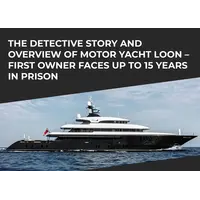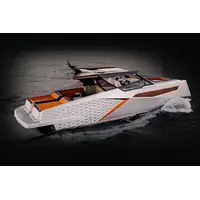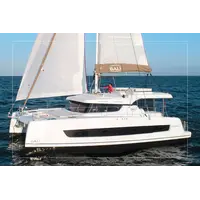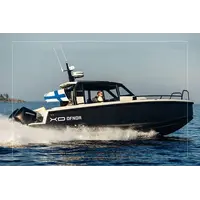topRik team talks about their experience testing the Aquila 54 motor catamaran from the Aquila shipyard Power Catamarans - a joint brainchild of the Chinese company Sino Eagle Yachts and American MarineMax.
The review is accompanied by photographs, layout plans and videos, we also traditionally present the opinion of famous yachting media about this Multihull of the Year 2021 winner with links to reviews from leading yachting journalists.
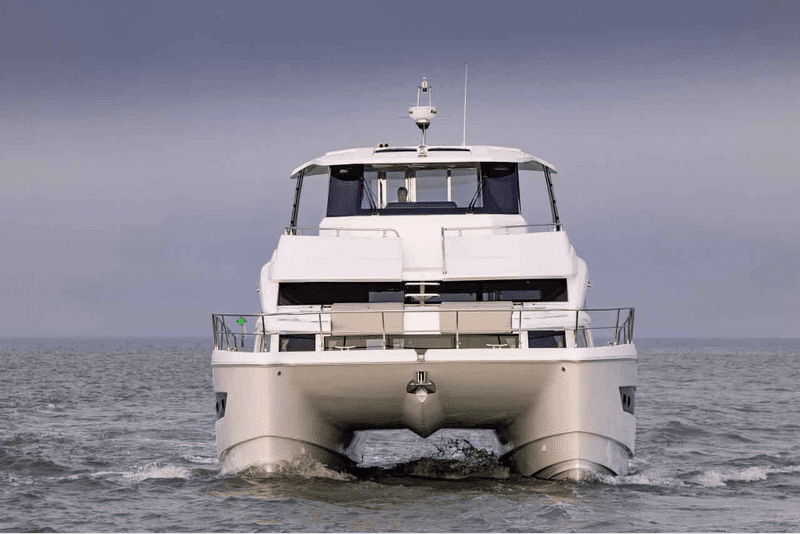
Yes, we remember: some representatives of the European and American maritime community laughed at the flowery statements of the new Chinese-American shipyard Aquila Power Catamarans. But very soon these chuckles about the shipyard’s “world leadership in the mass production of motor catamarans” began to fade as sales grew and the victories of Aquila catamarans in international competitions became more frequent.
The world premiere of the motor cat Aquila 54 was a triumph - it won the recently held Multihull of the Year 2021 competition. This confirms the predictions of experts that multihull yachts are becoming increasingly in demand, since a separate competition has been organized for them, and that Aquila Power Catamarans unmistakably chose the main direction of production. It should be added that the judges in this new competition were any interested sailors, including the owners of the nominated boats. 8,300 votes were cast for the nominees and winners of 2021, making the victory of the hero of our review more convincing.
But motor catamarans are also produced by more famous shipyards. Why was the prize given to Aquila 54? The secret was revealed by representatives of the shipyard, explaining that this success was due to demand studies and painstaking work to improve performance. Research conducted by shipyard marketers showed that catamaran owners and potential buyers of monohulls are dissatisfied with the fact that these boats are too... boxy. Well, something that was constantly mentioned by topRik experts, who compared flybridge catamarans with floating houses of the Victorian era. The sailors wanted the boat (especially the large one) to look not like Aunt Paulie’s cottage, but like a superyacht. And Aquila Power Catamarans gave them that aesthetic.
The gradually tapering silhouette of the Aquila 54 ends with a flybridge closed on all sides, which looks like the second deck of a superyacht. This effect is enhanced by the Portuguese bridge, the ladder from it to the main deck in the bow and, of course, the solid bow deck.
A distinctive feature of superyachts is the maximum of enclosed deck space, and the developers of Aquila Power Catamarans followed this principle when creating the Aquila 54's exterior.
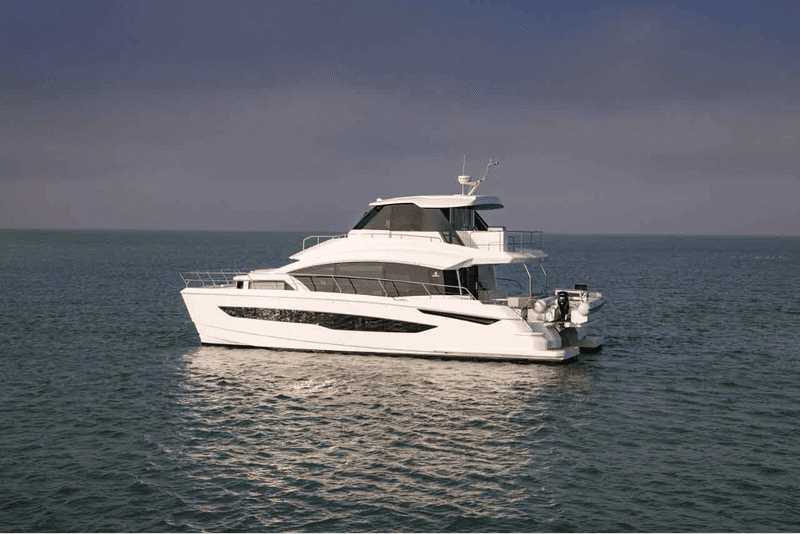
But the aesthetics of a vessel, especially a motor vessel, is not the most important thing for a yachtsman. And the Aquila 54 received their recognition not only for its appearance, but also for its innovations, which significantly improved the performance of the yacht. Actually, the classic inclined stem, bulbous bow and sprayers on each hull are not exactly innovative. These are well-known methods of combating the resistance of the water mass. But at a time when most of the cats from well-known manufacturers switched to a reverse stem, and bulbous bow was considered useless for use on boats less than 20-30 meters in length, the combination of these engineering solutions can be considered an innovation. After all, the main thing is the result, and it is impressive: the maximum cruising speed of the Aquila 54 is 21 knots. Not bad for a cat of this size weighing more than 23 tons (unladen and without passengers). Let’s add: it’s not a sports cat and it is mass-produced.
In our review of the Aquila 42, we already discussed that a significant part of the overall balance of water resistance to the movement of the boat and the engine power consumed is the energy spent on creating waves. These costs can be reduced by transferring the vessel to qualitatively new modes of motion: planing, hydrofoils or air cushion. In such modes of motion, wave resistance is practically absent: the waves that appear as a result of the action of the hydrodynamic pressure field under the bottom of the glider or hovercraft are usually small and the power spent on overcoming pressure resistance is much less than the power required to overcome friction forces and air resistance. However, to transfer the vessel to a new mode of motion, a sufficiently large engine power is required, which is selected at the rate of 1 HP for every 25-30 kg of vessel weight. At the same time, a number of complex design problems must be solved.
The main reserve for reducing the wave resistance of a displacement vessel is to reduce the height and mass of the bow wave that occurs in the zone of increased hydrodynamic pressure when the moving hull meets an undisturbed mass of water. The height of this wave and its profile depend on the distribution of hydrodynamic pressure near the stem and displacement along the length of the hull, on the sharpness of the contours of the bow end of the vessel.
Let us compare, for example, the wave formation during the movement of a tugboat and a work boat of the same displacement. When a tugboat with full bow contours moves, a very steep and high wave arises, the bow shaft moves outward from the sides, and the entire vessel appears to be positioned, at bow and stern, on two crests.
The mass of the wave at the stem, which has a strongly pointed bow, is noticeably less than that of a tugboat. We can confidently say that with equal engine power, such a boat can reach higher speeds than a tugboat. Thus, by changing the bow contours of the hull, the designer can reduce the power required to create a bow wave system.
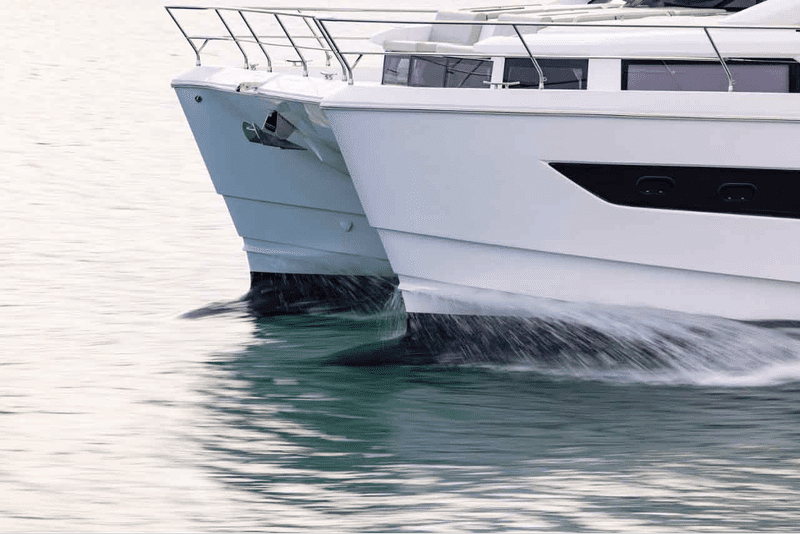
The height of the bow breaker on a boat with a sharp entry waterline can be reduced by installing splash guards or sprayers on the sides above the waterline. It is necessary to identify areas of the sides that are wetted with water while moving, and attach the pads to them. A slight inclination of the spray deflectors is needed so that when meeting a wave they do not “stick” into the water and do not “drown” the bow. Correctly placed pads help the boat overcome the oncoming wave and cut off the water, preventing it from rising to the deck.
The characteristic impedance can be reduced by using the principle of interference - the superposition of two successive wave systems in such a way that they cancel each other out. One of the constructive solutions to this problem is to use bulbous contours of the bow end of the vessel.
Bulb, which is a well-streamlined body moving underwater in front of the ship's stem, forms its own wave. The stream of water running down from the bulb approaches the point where the crest of the bow wave rises with low pressure (if there were no ship's hull, a depression would form here on the surface of the water). The trough of the wave from the bulb is superimposed on the crest of the wave from the stem. As a result, the bow wave “settles”, and the height of transverse waves along the entire length of the vessel also decreases. Studies have shown the possibility of reducing the overall resistance of the vessel as a result of using a bulb up to 18%, which gives an increase in speed with the same engine power of up to 4-5%.
And since the catamaran is not a planing vessel, but a displacement vessel, the developers also used bulbous bow, splitters, and a few more tricks to improve the performance of the Aquila 54.
The increased clearance of the tunnel between the hulls of the catamaran is noticeable to the naked eye when compared with models of the same size from other manufacturers. This prevents even a strong wave from reaching the solid bow deck, which is used on this skate instead of traditional nets (trampolines). In addition, the wave divider running through the center of this tunnel also reduces the force of the oncoming flow.
Now let’s see how all of this works in practice!
Features of Aquila 54
- Brand: Aquila
- Hull type: Catamaran
- Overall length, m: 16.5
- Overall length, ft: 54
- Width, m: 7.68
- Draft, m: 1.37
- Displacement, t: 23.3
- Water tanks, l: 1000
- CE Certification: A - 12 pax, B - 12 pax, C - 20 pax, D - 30 pax
- Engines: 2x D6 380 HP Volvo Penta Inboard Diesel
- Engine quantity: 2
- Power, HP: 2 x 380
- Option engine: 2 x D6 480 HP Volvo Penta Inboard Diesel / 2 x 550 HP Cummins QSB6.7 Inboard Diesel
- Fuel tanks, l: 2200
- Propeller type: 4 Blade
Maximum Speed and Fuel Consumption
| Max speed | Up to 21 knots |
| Cruising speed | Up to 17 knots |
| Fuel consumption | 127 l/h when planning at a speed of 17 knots |
Review of Aquila 54 by topRik Team
topRik experts expressed their first impression of the Aquila 54 catamaran in the introductory part of the article, perhaps overusing technical details a little. We will begin our study of the boat right from the transom. Keep up!
At the Transom
There is a lot to see and admire here. This is what this part of the catamaran looks like when fully assembled while moving. Both gates leading to the cockpit are closed, the middle part of the platform is raised.
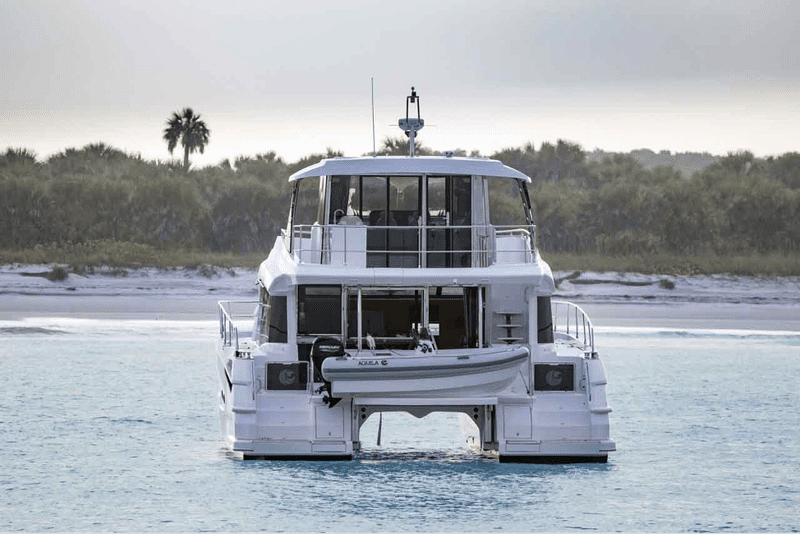
The RIB placed on it is supported by a pulley system assembled on a special dinghy beam.
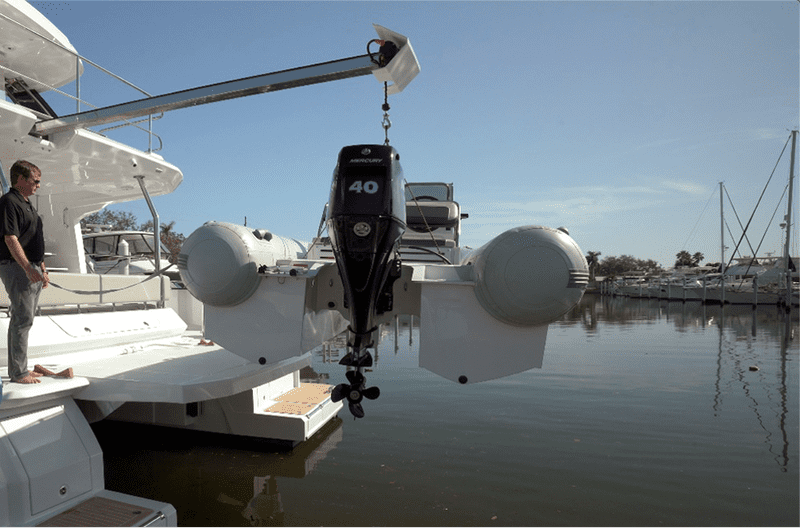
But if you are going to make a stop at sea or ocean (the design of the Aquila 54 is CE certified for access to the ocean, provided there are no more than 12 passengers on board), then this part of the catamaran will become a private beach for passengers at their own recreation center.
The platform descends to the level of the lowest steps of the ladder, and you get a huge “coastline” without stones, pebbles, shells and uneven terrain. You can use the outboard ladder to go down into the water and from the platform to switch to other floating devices from a set of various water toys.
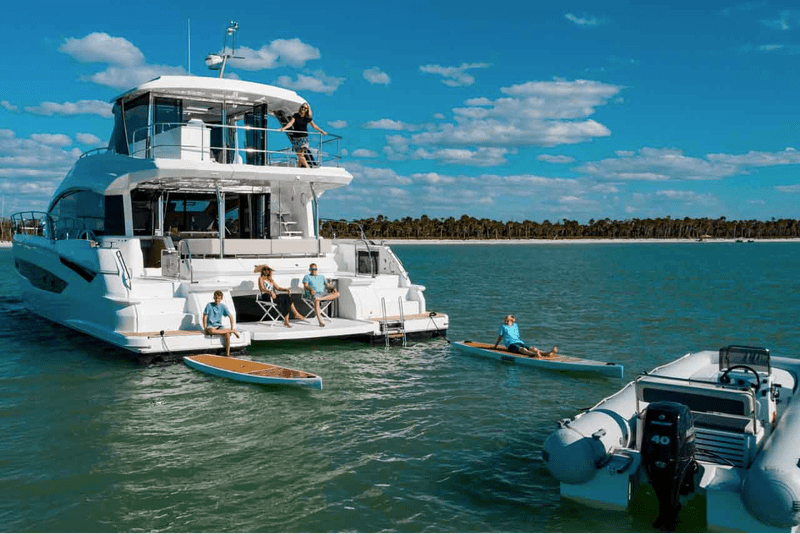
The middle can be used as a terrace for a beach cafe. Moreover, you don’t have to go far for drinks and ice cream - they are in the refrigerators of the saloon and flybridge... But it seems that we are getting ahead of ourselves. For now, we only have to climb into the cockpit through any of the gates located on both sides.
Inside the Cockpit
Oh no, this cockpit is not “just” an area. This is a fairly spacious space with a large aft C -shaped sofa from gate to gate. It is deployed into the cockpit and goes around a large table on 3 sides. There is enough room on the fourth side of the table to place additional chairs if a large group gathers for lunch.
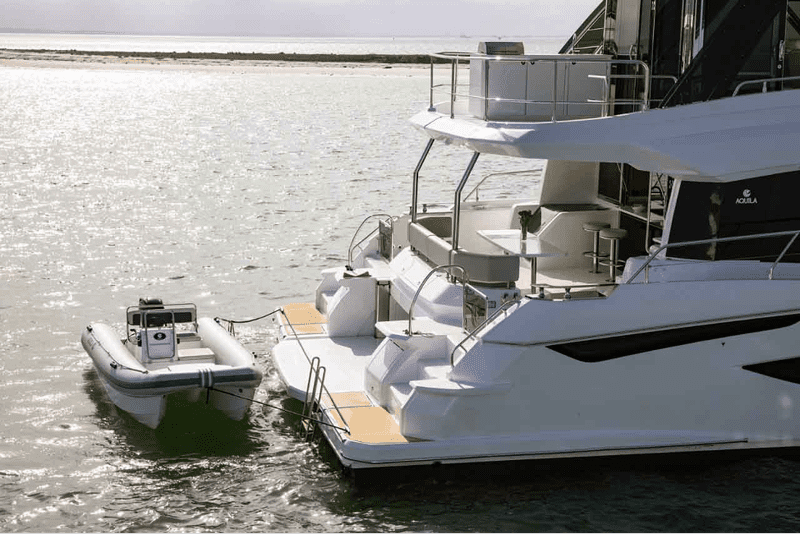
If there is not enough space for someone at the table, they can sit on stools in front of the bar counter, the role of which is played by one of the galley tables located in the saloon. In order to organize a bar in the cockpit, you just need to raise part of the partition between the cockpit and the saloon.
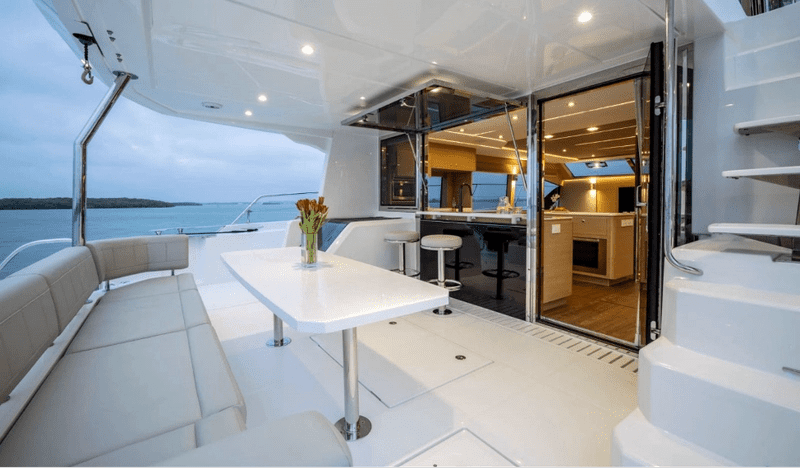
On the left side there is an entrance to one of the passenger cabins and a ladder to the side deck, on the right there is a ladder to the side deck.
The transparent shaded partition between the saloon and cockpit consists of several parts, including a large door and opening windows. In case of bad weather and during a cruise in cold seas, the cabin can be tightly “battened down” and the heating system can be turned on.
Checking Out the Saloon
But since the saloon door is hospitably open, let’s go there next! But first (albeit with some delay) we suggest that you familiarize yourself with the layout of the main deck. We have already passed some of its zones, but we still have a lot left, so the layout plan will help to locate the objects and zones, which we will talk about later.
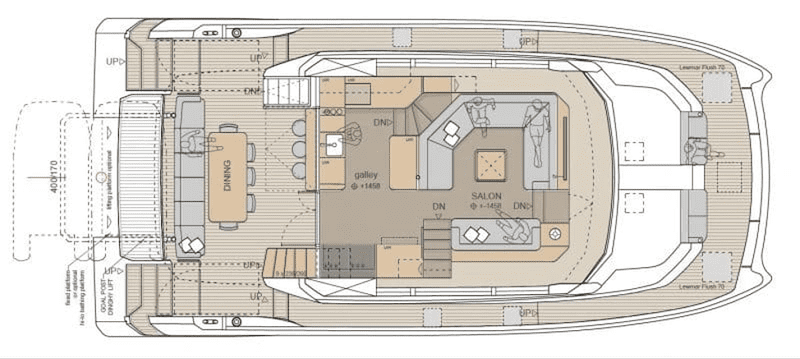
It is difficult to fit the entire huge interior in one photo, so we will explore it in parts. To the port side, as you may have guessed, there is a full-fledged galley, or rather, a well-equipped home kitchen. A table with a large work surface is located near the window overlooking the cockpit.
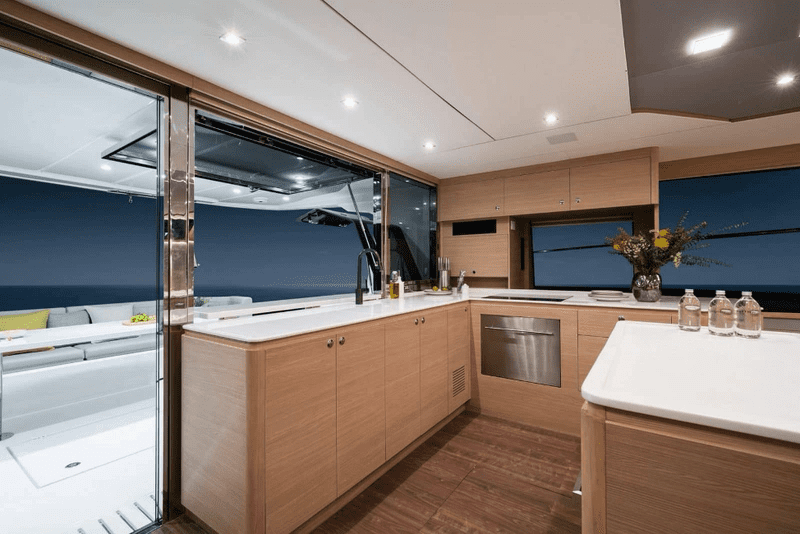
The owner can fill all other tables, cabinets, shelves and niches with any kitchen equipment he needs from the standard and optional list, kitchen utensils, dishes and products of different shelf life, including in a large refrigerator or freezer. The owner can choose the version of the stove (induction, gas, electric, etc.), oven, grill (plancha), dishwasher and other kitchen equipment.
Some of the refrigeration and freezing equipment (for wine, in particular) is located in the island cabinet, which separates the galley from the saloon, and its work surface serves as another bar counter for serving dishes from the galley to the saloon dining area.
But the largest refrigerator is located on the opposite side along with additional storage space. And the other part with an electrical panel and indicators that record the vital activity of all cat systems can be used as a chart table - there is also a drawer for storing paper maps. Of course, this is more of a tribute to tradition, and the fully equipped and secure helm station is located on the flybridge.
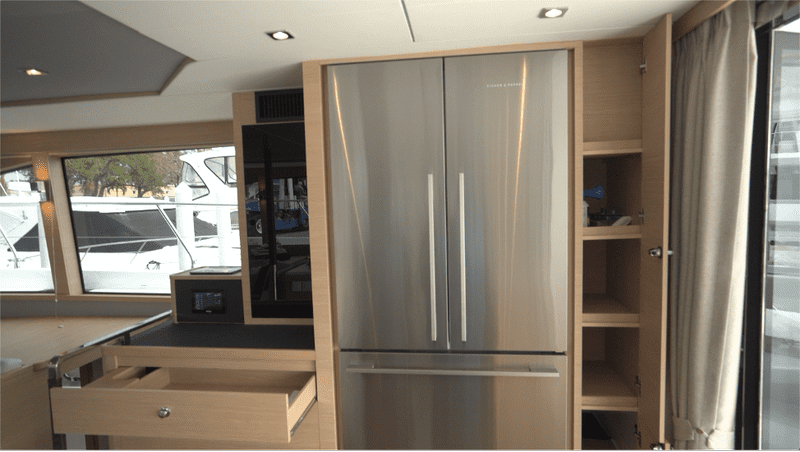
Another version of the Aquila 54 layout is available, in which the galley is located below, in place of one of the cabins of the 5-cabin version in the starboard hull. Then the space on the main deck that was intended for the galley will be occupied by soft, comfortable armchairs or a sofa near the cocktail (coffee) table.
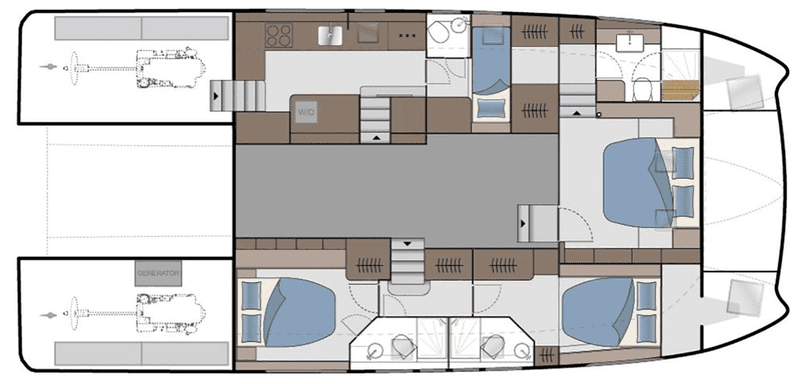
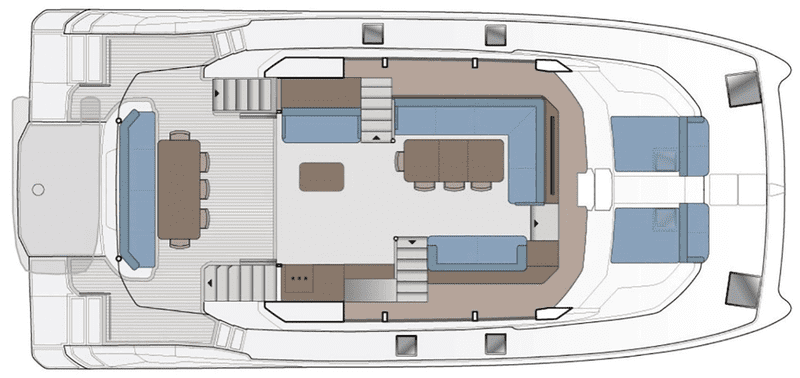
A significantly larger part of the saloon is dedicated to the “dining room,” or a place where all the inhabitants of the catamaran can gather for lunch, an evening cocktail, a friendly conversation or a party, what is called the wardroom on superyachts.
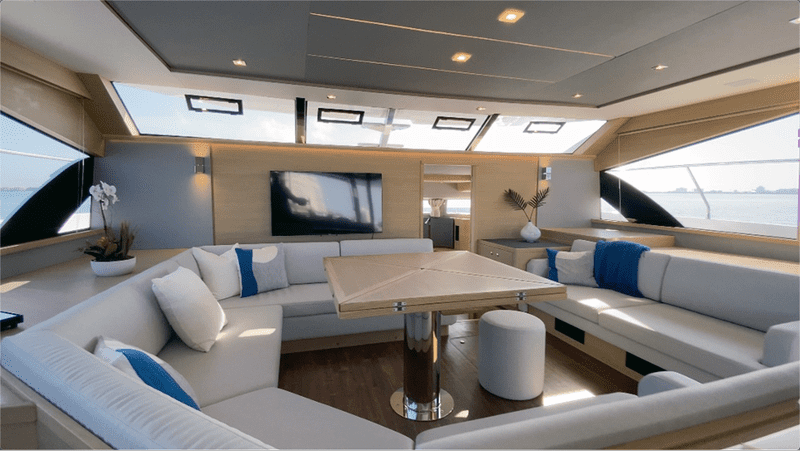
A large sofa in the shape of a pentagon without one side, where you can place poufs and a comfortable sofa along the starboard side, and in the middle - just a huge folding table - it can easily accommodate up to 20 people.
Well, as is usual with modular furniture on Aquila boats, this dining area, if necessary, can turn into a large sleeping area if you lower the tabletop and cover it with mattresses. What if unexpected guests have to spend the night on the yacht - anything can happen on cruises.
And of course, all conditions have been created for overnight accommodation for the yacht’s passengers and crew. In order to be convinced of this, you need to go down to the cabins: some from the deck, and some directly from the saloon.
In the Cabins
In the owner's version of the Aquila 54 the master cabin does not change its location across the entire width of the catamaran's bow - in versions with 3, 4 and 5 cabins, as well as when equipped with crew cabins in the forepeaks.
The diagrams below show the 4- and 5-cabin versions. The 3-cabin version is easy to imagine without a separate layout: a master cabin in the bow and one cabin in each float.
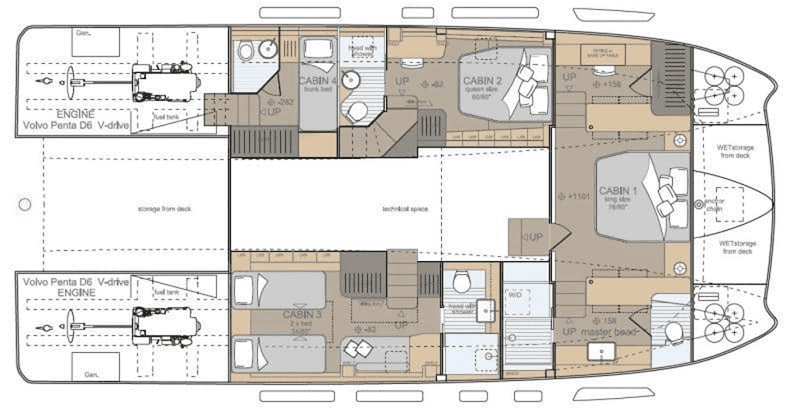
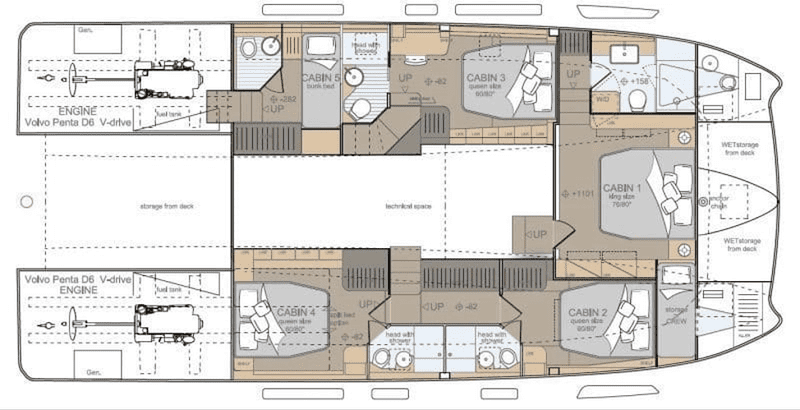
The master cabin is similar in comfort to a luxury hotel room, with a living room, a bedroom, and a separate bathroom with an isolated shower. The bathroom is located one floor below.
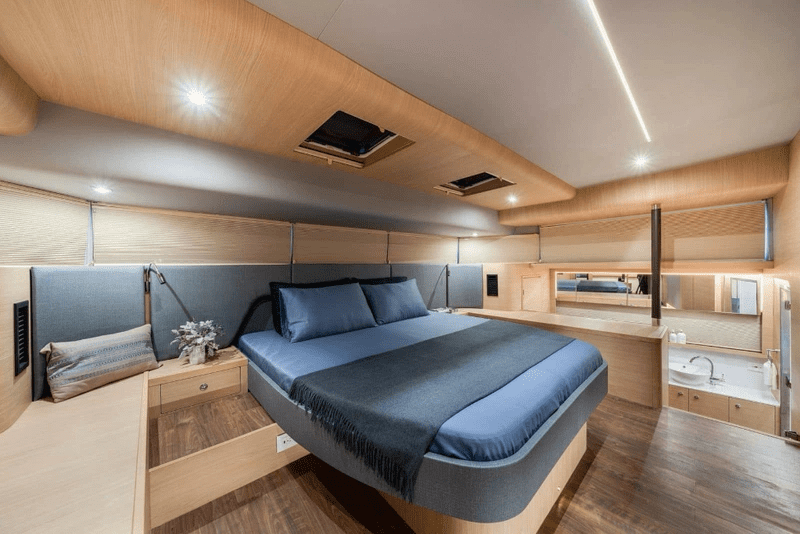
In the photo above, guests have gotten ready for bed and drawn the curtains, but if you open them, you will see that there is plenty of natural light, as well as fresh air coming through the skylights.
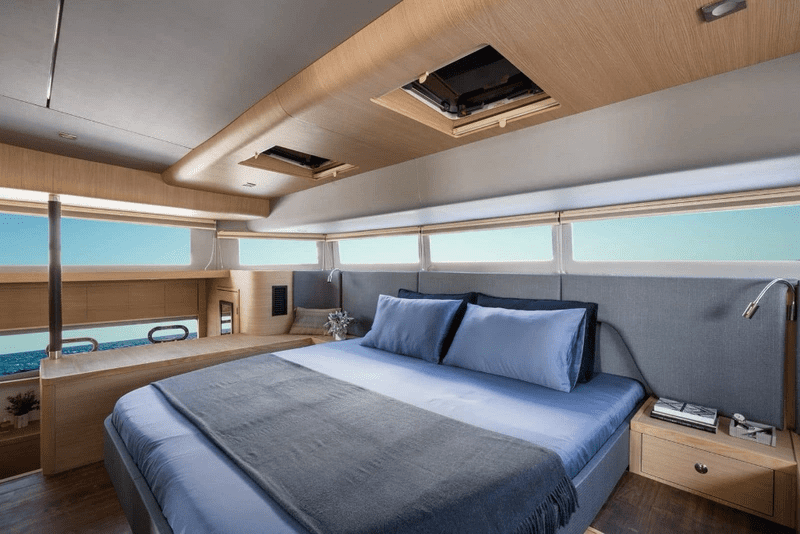
As in the cabins, which are located in the right and left floats. There is also a living room with a sofa and dressing table.
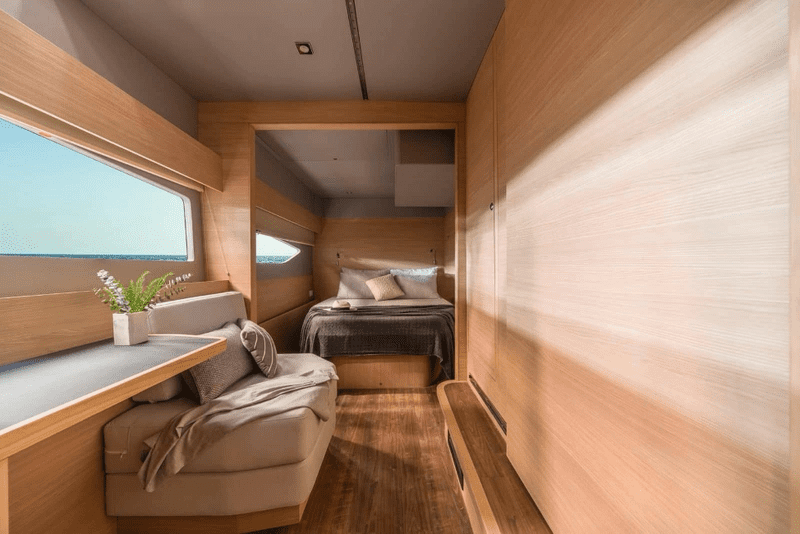
All cabins are equipped with separate bathrooms with everything necessary for hygiene procedures: washbasins, showers, toilets, mirrors, cabinets for storing toiletries.
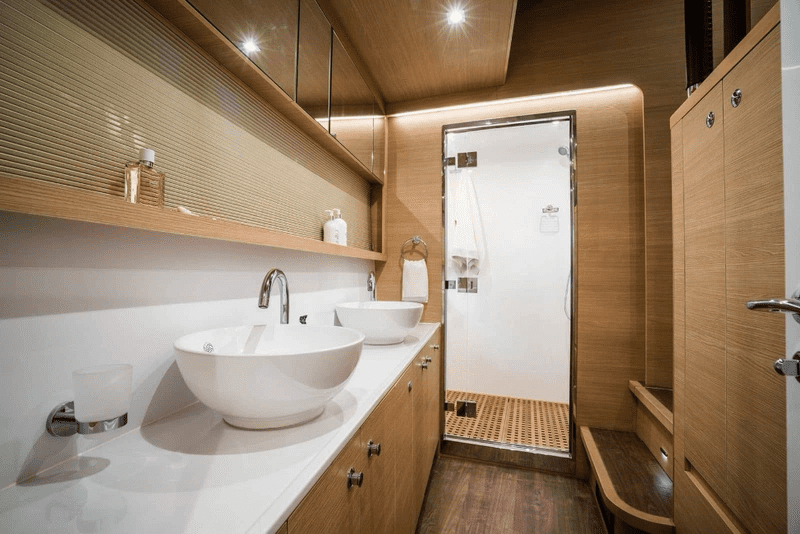
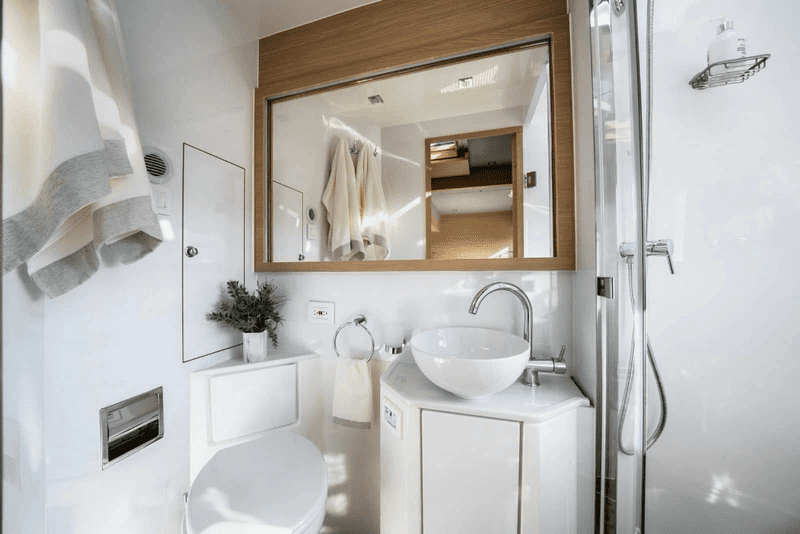
At the Bow Deck
Why do we go from the saloon to the foredeck, and not up to the flybridge? Because in the version we tested, there is no ladder from the saloon or cockpit, and we can only get to the flybridge via a ladder that leads there from the foredeck.
If you plan to permanently stay on the Aquila 54 in regions with a warm climate and lack of stormy weather, then the absence of an internal ladder is not particularly important. But in colder climates or in regions with frequent adverse weather conditions, it is still better to use the option of a ladder from the saloon so as not to go outside during a storm or cold.
The bow deck of the catamaran is another confirmation that we are dealing with a pleasure yacht: it is completely dedicated to an area with sun loungers, mattresses, pillows and sunbeds for every taste.
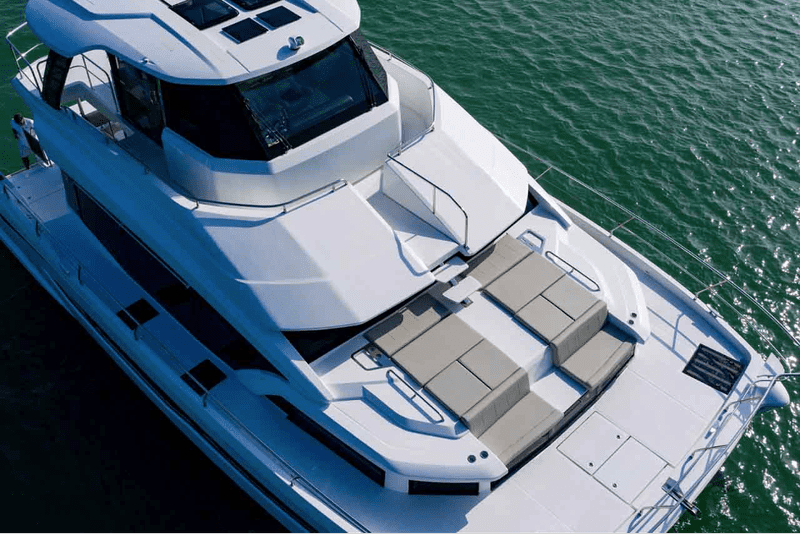
In the center of the bow there is a chain box with an anchor installation, and in the bow of each hull there is a hatch leading to the forepeak, which can be equipped as a crew cabin or an additional storage compartment.
A gangway between two rows of sun loungers leads to the flybridge.
On the Flybridge
Traditionally, we suggest that you familiarize yourself with the layout plan of this zone before learning more about it.
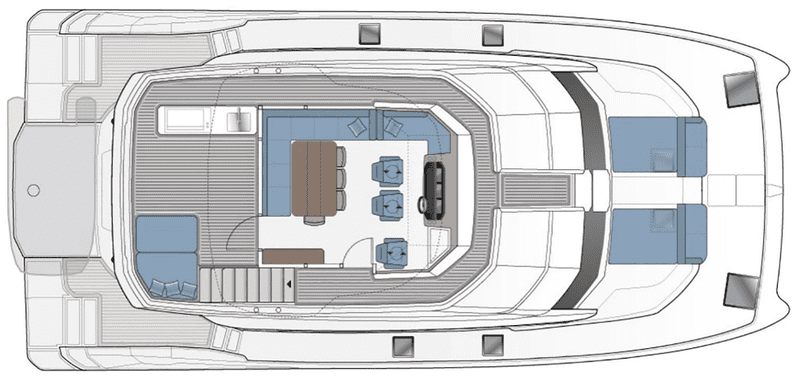
As can be seen from the plan, a large area of the flybridge is also given over to the social area, which includes a sunbathing area, galley and dining area.
The work area is a small area under the helm station with a helm panel and a row of seats, which, at the owner’s request, can be individual for the skipper, assistant and observer, or can be paired for the helmsman and assistant.
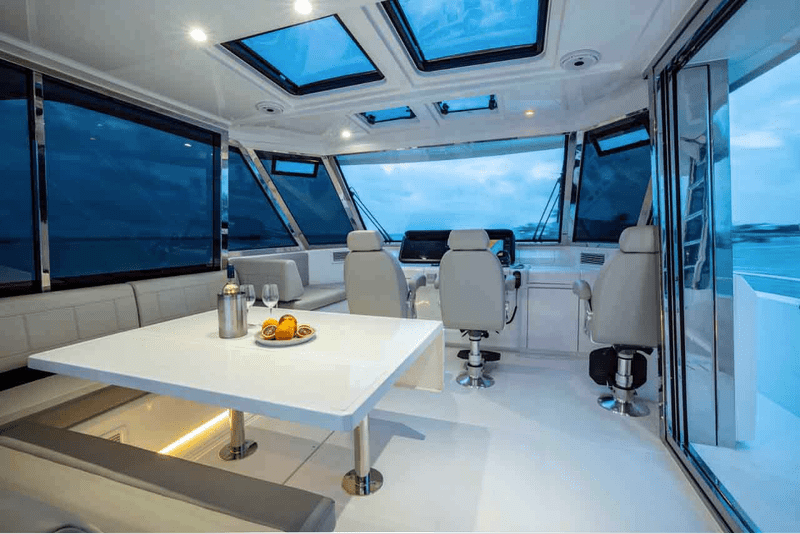
The well-equipped helm panel is intuitive even for beginners. In addition to the standard list, the owner is given the opportunity to supplement the panel with all the necessary equipment that he cannot do without on a cruise, including an additional display and indicators.
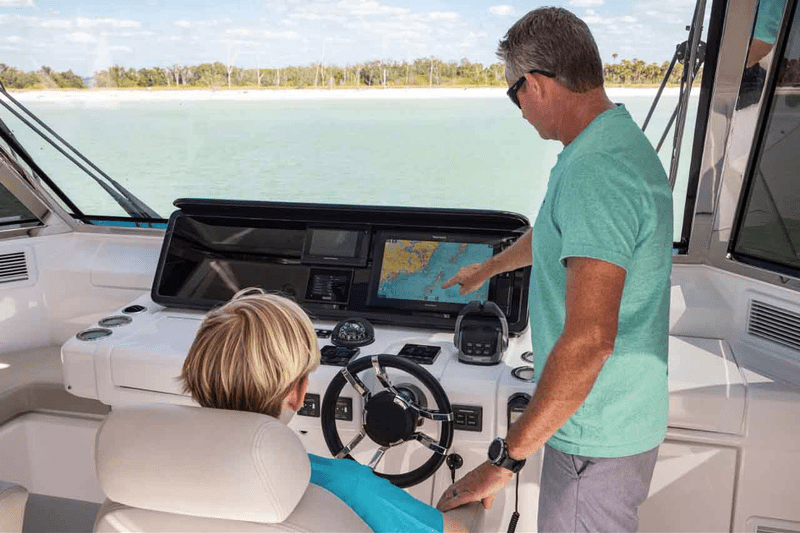
Almost all of these partitions, windows and hatches overhead can be opened if there is no need for climate control. Lots of air, lots of light and excellent all-round visibility from such a height... The flybridge is definitely a favorite place for the inhabitants of Aquila 54, especially considering that there is both a grill and refrigeration units.
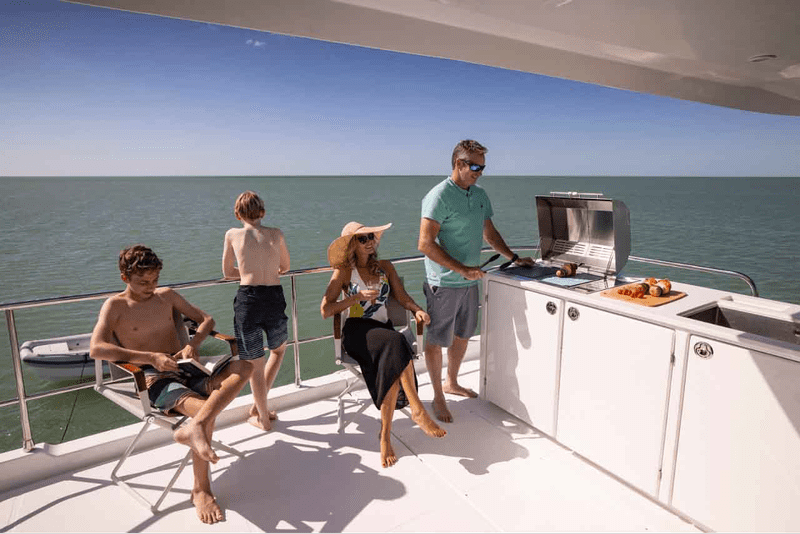
At the Sea
topRik experts were able to quickly verify that the stated maximum speed was even slightly underestimated. The catamaran that the topRik team tested was equipped with a pair of Volvos Penta D6, 480 HP. Therefore, at 3600 rpm we reached a maximum speed of 21 knots, and at 3650 rpm the speed indicator approached 22 knots.
Well, let's stop at the fact that the maximum cruising speed is 21 knots with a fuel consumption of about 185 l/h. topRik experts considered a speed of 17 knots with a fuel consumption of 127 l/h to be comfortable. If you need to enter an efficiency mode, but still move faster than a sailboat, then pay attention to the speed of 11-12 knots with fuel consumption of 77 and 95.5 l/h respectively.
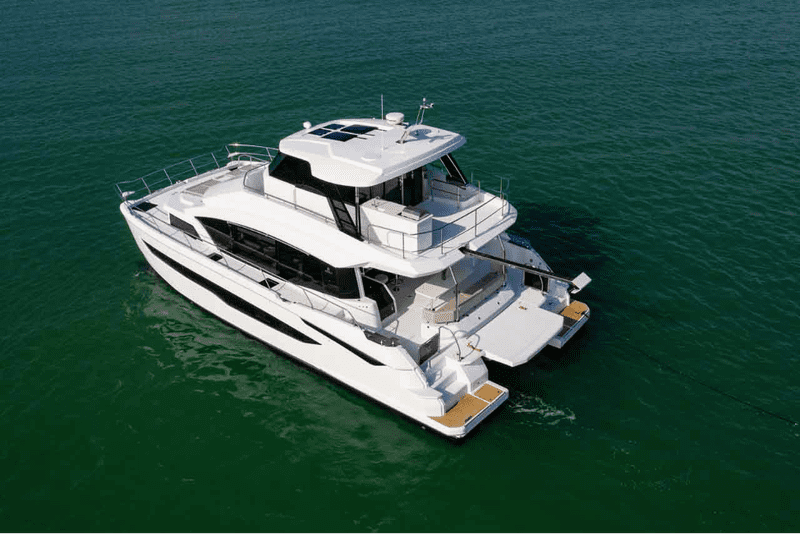
Advantages of Aquila 54
Since we are accustomed to starting this section with shortcomings, one of our crew members complained that the railing of the bow gangway doesn’t continue go for all its length. For an experienced sailor or trained passenger this is not a problem, but the boat can be purchased for a family with elderly people and small children. The team supported this claim and arguments.
In all other respects, the Aquila 54 motor catamaran is impeccable: from ease of driving to performance, from comfort for passengers and helmsman (crew) to huge areas for recreation.
Unusually comfortable, if the owner wishes, it is a luxury yacht, close in spirit and appearance to superyachts. At the same time, it has excellent driving characteristics - decent cruising speed, efficient fuel consumption, simple controls and responsiveness to steering.
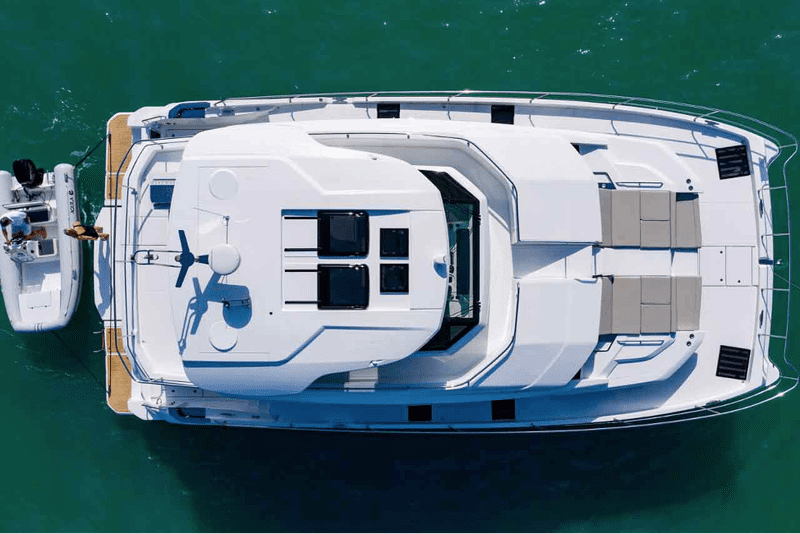
Reviews of Aquila 54 from Professionals
Yacht Style magazine, which positions myself as Asia's leading yachting lifestyle media, posted review dedicated to Aquila 54 by Dominic Salandre.
Video Reviews of Aquila 54
Time to see how this yacht looks in motion. We gathered best videos on this model that we could find.
First, short and informative review by the Boat Show:
Next, video from the Aquila Boats themselves:
Another review from Aquila Boats, but this one lasts for 25 minutes and has tons of information:
Unique experience of this yacht’s owner from his own perspective:
Short teaser showcasing main features in case you want to check out basics only:
Conclusion
It is impossible to name a category of lovers of comfortable and safe cruises, including the ocean crossings, who would not be suitable for this boat.
From the father of a family to a romantic couple, from lovers of cruises in a large group of friends to those who like to spend holidays in a small group, from beginners in sailing to experienced sailors who want to take a break from the sails - Aquila 54 is a long-awaited dream for everyone. Which, by the way, can easily be turned into reality through the topRik marketplace. Based on our own experience, our experts unanimously stated that the catamaran will also be in demand among charter companies.
Where to Buy Aquila 54 at a Bargain Price
If you want to buy this incredible yacht at a good price, the topRik team is at your service. You can entrust us with the entire process - from negotiations with the manufacturer about a favorable price for you and to the delivery of the yacht to the location you specify. In this case, we will take care of the paperwork and control of the equipment at the place of production or shipment of the catamaran.
All preliminary consultations are free, the virtual configurator is free also.
Or we can provide ongoing purchase support so that you do not make any mistakes at any stage.
Call our experts using the phone number above, use the website feedback form, or send a message to [email protected].



